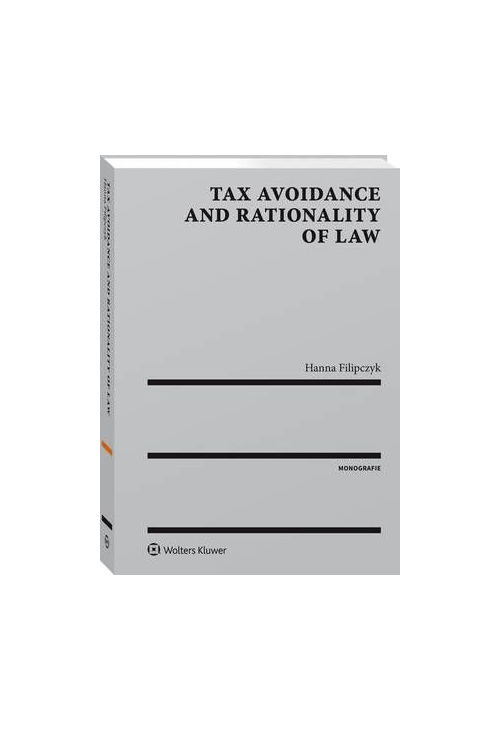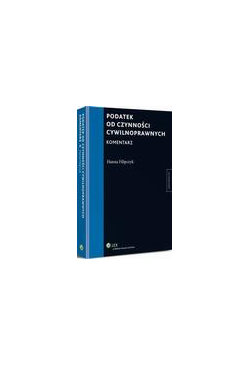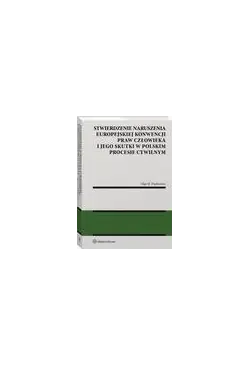
- -11%
ebook Tax avoidance and rationality of law
Czy jesteś gotowy na odkrycie świata zaawansowanej wiedzy podatkowej? Nasza najnowsza książka elektroniczna "Tax avoidance and rationality of law" autorstwa Hanny Filipczyk, wydana przez Wolters Kluwer w 2017 roku, jest kluczem do zrozumienia złożonych mechanizmów unikania opodatkowania.
Oto publikacja, która wciągnie Cię w fascynującą podróż po zakamarkach prawa podatkowego i etyki. Jeśli interesujesz się ebookami literaturą piękną lub najlepszymi bestsellerami ebooków, ta książka jest dla Ciebie.
"Tax avoidance and rationality of law" to nie tylko teoretyczna podróż, ale również praktyczny przewodnik po świecie unikania opodatkowania i skutecznych strategii jego zwalczania. Autorka Hanna Filipczyk wprowadza czytelnika w świat "podatkowych termitów" i przedstawia, jak za pomocą różnorodnych narzędzi prawnych można przeciwdziałać tym zjawiskom.
Książka ta jest odpowiedzią na współczesne wyzwania stojące przed systemem podatkowym i stanowi ważny głos w debacie o aspektach prawnych i etycznych unikania opodatkowania. Dla miłośników ebooków, którzy cenią sobie wiedzę z zakresu ekonomii oraz prawa, ta publikacja jest nieocenionym źródłem informacji.
Nie czekaj dłużej! Pobierz swój ebook w wygodnym formacie PDF i zanurz się w świecie zaawansowanej wiedzy podatkowej. Nasza księgarnia ebooków oferuje najlepsze wydania elektroniczne, które są dostępne do natychmiastowego pobrania. Odkryj bogaty wybór ebooków i ciesz się komfortem czytania na dowolnym urządzeniu.
"Tax avoidance and rationality of law" to idealna propozycja dla osób poszukujących wartościowych treści ebookowych, które łączą teorię z praktyką. Zapraszamy do sklepu z ebookami i kupienia tego niezwykłego e-booka już dziś!
Spis treści ebooka Tax avoidance and rationality of law
Abbreviations and Acronyms , str. 11Foreword , str. 13
Chapter I
Introduction , str. 15
1. Purpose of the study , str. 15
2. State of the art , str. 17
3. Lawmaking and interpretation , str. 19
4. Methodology of the study , str. 22
5. Structure of the study , str. 24
Chapter II
Tax avoidance - the concept , str. 27
1. Introductory remarks , str. 27
2. In search of a definition , str. 29
2.1. Three criteria of tax avoidance , str. 29
2.2. Defeating the purpose of the law , str. 30
2.3. Artificiality , str. 33
2.4. Tax minimisation motive , str. 44
3. Distinctions , str. 52
3.1. Tax avoidance - tax evasion - tax planning , str. 52
3.2. Tax avoidance - sham transactions , str. 58
3.3. Tax avoidance - aggressive tax planning - base erosion and profit shifting , str. 61
4. Conclusions , str. 65
Chapter III
Justification for countering tax avoidance , str. 67
1. Introductory remarks , str. 67
2. Rule of law and anti-avoidance rules , str. 68
2.1. Rule of law , str. 68
2.2. Legitimacy (legality) , str. 73
2.3. Certainty , str. 74
2.4. Formal equality , str. 80
3. The puzzle of tax avoidance , str. 83
3.1. The illegal and the immoral , str. 83
3.2. ",Fair share", , str. 85
3.3. Consequences of tax avoidance , str. 90
3.4. Corporate social responsibility , str. 92
3.5. Right to tax minimisation , str. 97
4. Conclusions , str. 103
Chapter IV
Rationality of law , str. 105
1. Introductory remarks , str. 105
2. Law and interpretation , str. 108
2.1. Communicative nature of law , str. 108
2.2. Interpretation as attribution of meaning , str. 109
2.3. Interpretation as optimisation within constraints , str. 114
2.4. Interpretation as attribution of communication intentions , str. 123
3. Rationality of law as intelligibility , str. 131
3.1. Intelligibility and its three aspects , str. 131
3.2. Communicativeness , str. 133
3.3. Reasonability (justifiability) , str. 148
3.4. Coherence , str. 154
4. Conclusions , str. 165
Chapter V
Tax avoidance and rationality of law , str. 167
1. Introductory remarks , str. 167
2. Tax avoidance as defeating rationality of law , str. 168
2.1. Communicativeness , str. 168
2.2. Reasonability (justifiability) , str. 175
2.3. Coherence , str. 180
3. Why rationality? , str. 183
4. Certainty, equality and dignity , str. 192
5. Conclusions , str. 202
Chapter VI
Rationality of income tax law , str. 205
1. Introductory remarks , str. 205
2. What to tax? Concept of income , str. 207
2.1. Origins , str. 207
2.2. From economic phenomenon to legal construct , str. 209
2.3. Ectopia of income taxation (Prebble) , str. 218
3. Where to tax? Allocation of taxing rights , str. 225
3.1. Paradigm , str. 225
3.2. Crisis , str. 229
3.3. Solutions , str. 239
4. How to tax? Formalism , str. 250
4.1. State of complexity , str. 250
4.2. Reasons , str. 254
5. Conclusions , str. 264
Chapter VII
Countering tax avoidance , str. 267
1. Introductory remarks , str. 267
2. Principle-based legislation , str. 268
2.1. What PBL is (empirically) , str. 268
2.2. What PBL should be (theoretically) , str. 270
2.3. Rationality of law , str. 280
2.4. Objections , str. 283
3. General anti-avoidance rules , str. 291
3.1. What a GAAR is (empirically) , str. 291
3.2. What a GAAR should be (theoretically) , str. 295
3.3. Rationality of law , str. 304
3.4. Objections , str. 306
4. Programmes of co-operative compliance (CC) , str. 316
4.1. What CC is (empirically) , str. 316
4.2. What CC should be (theoretically) , str. 322
4.3. Rationality of law , str. 328
4.4. Objections , str. 330
5. Conclusions , str. 335
Chapter VIII
",Power and trust", , str. 337
1. Introductory remarks , str. 337
2. Contemporary models of tax compliance , str. 338
2.1. Model of economic rationality and new reflection , str. 338
2.2. ",Responsive regulation", , str. 341
2.3. ",Power", and ",trust", - ",slippery slope", framework , str. 344
2.4. Procedural justice , str. 348
3. Relevance for tax avoidance , str. 350
3.1. Shades of non-compliance , str. 350
3.2. Applicability to tax avoidance , str. 353
3.3. Coercive and non-coercive measures , str. 356
3.4. Effectiveness and fairness of tax law , str. 357
4. Conclusions , str. 360
Summary and conclusions , str. 361
Legal acts and proposals , str. 371
Literature and sources , str. 373
Szczegóły ebooka Tax avoidance and rationality of law
- Wydawca:
- Wolters Kluwer
- Rok wydania:
- 2017
- Typ publikacji:
- Ebook
- Język:
- polski
- Format:
- Liczba stron:
- 396
- ISBN dla wersji papierowej:
- 9788381076739
Recenzje ebooka Tax avoidance and rationality of law
-
Reviews (0)

Na jakich urządzeniach mogę czytać ebooki?
- -11%


















@CUSTOMER_NAME@
@COMMENT_TITLE@
@COMMENT_COMMENT@